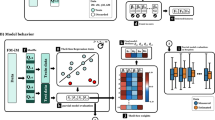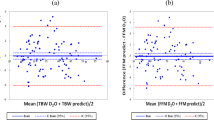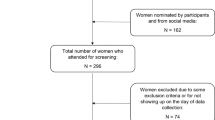Abstract
Objective: To test the validity of a simple, rapid, field-adapted, portable hand-held impedancemeter (HHI) for the estimation of lean body mass (LBM) and percentage body fat (%BF) in African women, and to develop specific predictive equations.
Design: Cross-sectional observational study.
Setting: Dakar, the capital city of Senegal, West Africa.
Subjects: A total sample of 146 women volunteered. Their mean age was of 31.0 y (s.d. 9.1), weight 60.9 kg (s.d. 13.1) and BMI 22.6 kg/m2 (s.d. 4.5).
Methods: Body composition values estimated by HHI were compared to those measured by whole body densitometry performed by air displacement plethysmography (ADP). The specific density of LBM in black subjects was taken into account for the calculation of %BF from body density.
Results: Estimations from HHI showed a large bias (mean difference) of 5.6 kg LBM (P<10−4) and −8.8 %BF (P<10−4) and errors (s.d. of the bias) of 2.6 kg LBM and 3.7 %BF. In order to correct for the bias, specific predictive equations were developed. With the HHI result as a single predictor, error values were of 1.9 kg LBM and 3.7 %BF in the prediction group (n=100), and of 2.2 kg LBM and 3.6 %BF in the cross-validation group (n=46). Addition of anthropometrical predictors was not necessary.
Conclusions: The HHI analyser significantly overestimated LBM and underestimated %BF in African women. After correction for the bias, the body compartments could easily be estimated in African women by using the HHI result in an appropriate prediction equation with a good precision. It remains to be seen whether a combination of arm and leg impedancemetry in order to take into account lower limbs would further improve the prediction of body composition in Africans.
This is a preview of subscription content, access via your institution
Access options
Subscribe to this journal
Receive 12 print issues and online access
$259.00 per year
only $21.58 per issue
Buy this article
- Purchase on Springer Link
- Instant access to full article PDF
Prices may be subject to local taxes which are calculated during checkout

Similar content being viewed by others
References
Baumgartner RN (1996): Electrical impedance and total body electrical conductivity. In: Human Body Composition, eds. AF Roche, SB Heymsfield & TG Lohman, pp 79–107. Champaign: Human Kinetics.
Baumgartner RN, Chumlea WC &, Roche AF (1989): Estimation of body composition from bioelectrical impedance of body segments. Am. J. Clin. Nutr. 50, 221–226.
Bell NA, McClure PD, Hill RJ &, Davies PSW (1998): Assessment of foot-to-foot bioelectrical impedance analysis for the prediction of total body water. Eur. J. Clin. Nutr. 52, 856–859.
Biaggi RR, Vollman MW, Nies MA, Brener CE, Flakoll PJ, Levenhagen DK, Sun M, Karabulut Z &, Chen KY (1999): Comparison of air-displacement plethysmography with hydrostatic weighing and bioelectrical impedance analysis for the assessment of body composition in healthy adults. Am. J. Clin. Nutr. 69, 898–903.
Bland JM &, Altman DG (1986): Statistical methods for assessing agreement between two methods of clinical measurement. Lancet 1, 307–310.
Bland JM &, Altman DG (1995): Comparing methods of measurement: why plotting difference against standard method is misleading. Lancet 346, 1085–1087.
Demerath EW, Guo SS, Chumlea WC, Towne B, Roche AF &, Siervogel RM (2002): Comparison of percent body fat estimates using air displacement plethysmography and hydrodensitometry in adults and children. Int. J. Obes. Relat. Metas. Disord. 26, 389–397.
Dempster P &, Aitkens S (1995): A new air displacement method for the determination of human body composition. Med. Sci. Sports Exerc. 27, 1692–1697.
Deurenberg P (1992): The Assessment of Body Composition: Uses and Misuses. Annual Report. Lausanne: Nestlé Foundation, pp 35–72.
Deurenberg P &, Deurenberg-Yap M (2002): Validation of skinfold thickness and hand-held impedance measurements for estimation of body fat percentage among Singaporean Chinese, Malay and Indian subjects. Asia Pacific J. Clin. Nutr. 11, 1–7.
Deurenberg P, Yap M &, Van Staveren WA (1998): Body mass index and percent body fat: a meta analysis among different ethnic groups. Int. J. Obes. Relat. Metab. Disord. 22, 1164–1171.
Deurenberg P, Andreoli A, Borg P, Kukkonen-Harjula K, de Lorenzo A, van Marken Lichtenbelt WD, Testolin G, Vigano R &, Vollaard N (2001): The validity of predicted body fat percentage from body mass index and from impedance in samples of five European populations. Eur. J. Clin. Nutr. 55, 973–979.
Deurenberg P, Deurenberg-Yap M &, Schouten FJM (2002): Validity of total and segmental impedance measurements for prediction of body composition across ethnic populations groups. Eur. J. Clin. Nutr. 56, 214–220.
Fields DA, Goran MI &, McCrory MA (2002): Body-composition assessment via air-displacement plethysmography in adults and children: a review. Am. J. Clin. Nutr. 75, 453–467.
Frisancho AR (1990): Anthropometric Standards for the Assessment of Growth and Nutritional Status. Ann Arbor: The University of Michigan Press.
Fuller NJ &, Elia M (1989): Potential use of bioelectrical impedance of the ‘whole body’ and of body segments for the assessment of body composition: comparison with densitometry and anthropometry. Eur. J. Clin. Nutr. 43, 779–791.
Guo SS &, Chumlea WC (1996): Statistical methods for the development and testing of predictive equations. In: Human Body Composition, eds. AF Roche, SB Heymsfield, TG Lohman, pp 191–202. Champaign: Human Kinetics.
Heyward V (2001): ASEP methods recommendation: Body composition assessment. J. Exerc. Physiol. on line 4, 1–12.
Houtkooper LB, Lohman TG, Going SB &, Howell WH (1996): Why bioelectrical impedance analysis should be used for estimating adiposity. Am. J. Clin. Nutr. 64(Suppl), 436S–448S.
Jebb SA, Cole TJ, Doman D, Murgatroyd PR &, Prentice AM (2000): Evaluation of a novel Tanita body-fat analyser to measure body composition by comparison with a four-compartment model. Br. J. Nutr. 83, 115–122.
Lukaski HC, Johnson PE, Bolonchuck WW &, Lykken GE (1985): Assessment of fat free mass using bioelectrical impedance measurement of the human body. Am. J. Clin. Nutr. 41, 810–817.
Lohman TG, Roche AF &, Martorell R (ed.) (1988): Anthropometric Standardisation Reference Manual. Champaign, IL: Human Kinetics.
McCrory MA, Gomez TD, Bernauer EM &, Mole PA (1995): Evaluation of a new air displacement plethysmography for measuring human body composition. Med. Sci. Sports Exerc. 27, 1686–1691.
Nunez C, Gallagher D, Visser M, Pi-Sunyer FX, Wang ZM &, Heymsfield SB (1997): Bioimpedance analysis: evaluation of a leg-to-leg system based on pressure contact foot-pad electrodes. Med. Sci. Sports Exerc. 29, 524–531.
Nunez C, Kovera AJ, Pietrobelli A, Heshka S, Horlick M, Kehayias JJ, Wang Z &, Heymsfield SB (1999): Body composition in children and adults by air displacement plethysmography. Eur. J. Clin. Nutr. 53, 382–387.
Ortiz O, Russell M, Daley TL, Baumgartner RN, Waki M, Lichtman S, Wang J, Pierson RN &, Heymsfield SB (1992): Differences in skeletal muscle and bone mineral mass between black and white females and their relevance to estimates of body composition. Am. J. Clin. Nutr. 55, 8–13.
Siri WE (1961): Body composition from fluid spaces and density: analysis of methods. In: Techniques for Measuring Body Composition, eds. J Brozek, A Henschel, pp 223–244. Washington, DC: National Academy of Sciences.
Snijder MB, Kuyf BEM &, Deurenberg P (1999): The effect of body build on the validity of predicted body fat from body mass index and bioelectrical impedance. Ann. Nutr. Metab. 43, 277–285.
Stewart SP, Bramley PN, Heighton R, Green JH, Horsman A, Losowsky MS &, Smith MA (1993): Estimation of body composition from bioelectrical impedance of body segments: comparision with dual-energy X-ray absorptiometry. Br. J. Nutr. 69, 645–655.
Wagner DR &, Heyward VH (2000): Measures of body composition in blacks and whites: a comparative review. Am. J. Clin. Nutr. 71, 1392–1402.
Wagner DR &, Heyward VH (2001): Validity of two-component models for estimating body fat of black men. J. Appl. Physiol. 90, 649–656.
Ward LC, Heitmann BL, Craig P, Stroud D, Azinge EC, Jebb S, Cornish BH, Swinburn B, O'Dea K, Rowley K, McDermott R, Thomas BJ &, Leonard D (2000): Association between ethnicity, body mass index, and bioelectrical impedance. Implications for the population specificity of prediction equations. Ann. N.Y. Acad. Sci. 904, 199–202.
Acknowledgements
We are indebted to the women who agreed to take part in the study.
Author information
Authors and Affiliations
Contributions
Guarantors: A Gartner, Y Schutz.
Contributors: F Delpeuch and B Maire initiated the project comprising this study and contributed to writing the manuscript. A Gartner was in charge of the study in Senegal and was the principal investigator. A Dioum was in charge of recruitment of the subjects and data collection from ADP. A Gartner and Y Schutz were responsible for data management and analysis, and were responsible for writing the manuscript.
Corresponding author
Rights and permissions
About this article
Cite this article
Gartner, A., Dioum, A., Delpeuch, F. et al. Use of hand-to-hand impedancemetry to predict body composition of African women as measured by air displacement plethysmography. Eur J Clin Nutr 58, 523–531 (2004). https://doi.org/10.1038/sj.ejcn.1601839
Received:
Revised:
Accepted:
Published:
Issue Date:
DOI: https://doi.org/10.1038/sj.ejcn.1601839



